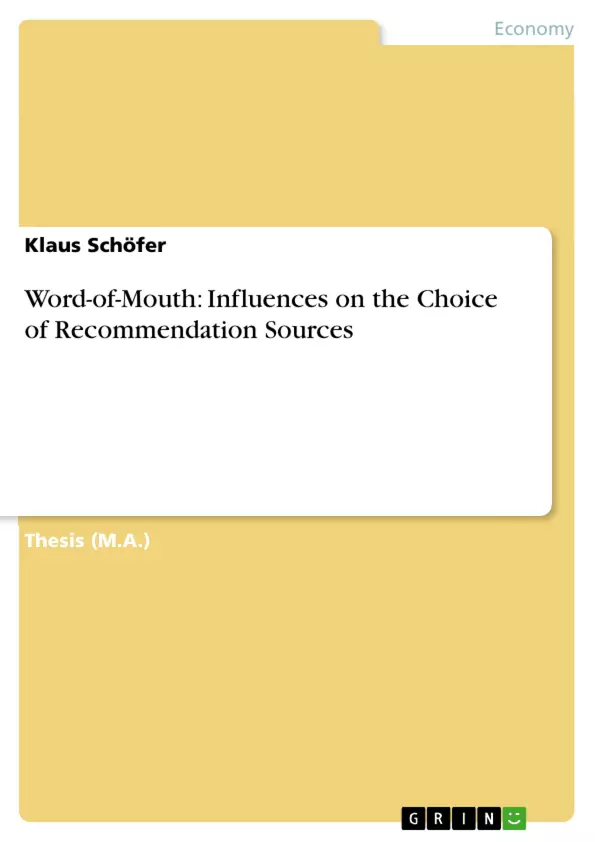The idea of understanding consumer behaviour as a sequential decision-making process is one that is common in marketing (Engel et al., 1993; Wilkie, 1994; Solomon, 1993; Assael, 1992; Loudon and Della Bitta, 1993; Kotler, 1997). The decision-making process itself is presented as a logical flow of activities, working from problem recognition to purchase to post-purchase evaluation. This decision-making process is affected by a number of other more complex influences. Some of these influences relate to the wider environment in which the decision is being made while others relate to the individual who makes the decision.
The main part of this paper is divided into two chapters. Chapter 2, that follows an introduction to the work, is a theoretical one. It is a review of the literature on consumer decision-making and the individual and environmental influences on it. Emphasis is being placed on WOM communication and its role in understanding consumer behaviour. Chapter 3 focuses on the choice of WOM recommendation sources. Empirical research is presented which explores the influences on the choice over WOM recommendation sources. Finally, concluding remarks and recommendations for further research can be found in chapter 4.
Inhaltsverzeichnis (Table of Contents)
- Chapter 1 Introduction
- Chapter 2 Literature Review
- 2.1 Consumer Decision-Making
- 2.1.1 The Decision-Making Process
- 2.1.1.1 Problem Recognition
- 2.1.1.2 Information Search
- 2.1.1.3 Evaluation of Alternatives
- 2.1.1.4 Purchase
- 2.1.1.5 Post-Purchase Evaluation
- 2.1.2 Individual Influences
- 2.1.3 Environmental Influences
- 2.1.3.1 Culture
- 2.1.3.2 Social Class
- 2.1.3.3 Reference Groups
- 2.1.1 The Decision-Making Process
- 2.2 Word-of-Mouth Communication
- 2.2.1 Definition
- 2.2.2 Scope and Significance
- 2.2.3 Characteristics of WOM
- 2.2.4 The Nature of WOM
- 2.2.4.1 Types
- 2.2.4.2 Process
- 2.2.4.3 Conditions
- 2.2.4.4 Motives
- 2.2.5 WOM and the Consumer Behaviour Literature
- 2.2.5.1 Adoption and Diffusion on Innovations
- 2.2.5.2 Post-Purchase Decision-Making
- 2.2.5.3 Pre-Purchase Decision-Making
- Chapter 3 Empirical Analysis
- 3.1 The Model
- 3.1.1 Recommendation Sources
- 3.1.2 Evaluative Cues
- 3.1.3 Task Difficulty
- 3.1.4 Prior Knowledge
- 3.1.5 Hypotheses
- 3.2 Research Context
- 3.3 Method
- 3.3.1 Research Instrument
- 3.3.2 Procedure
- 3.3.3 Sample
- 3.4 Results
- 3.5 Discussion
- 3.6 Limitations
- 3.1 The Model
- Chapter 4 Conclusion
Zielsetzung und Themenschwerpunkte (Objectives and Key Themes)
This dissertation examines the influences on the choice of recommendation sources, particularly in the context of word-of-mouth communication. The work aims to contribute to the existing research on consumer behavior by exploring the factors that influence how consumers select sources for recommendations and the role that word-of-mouth communication plays in this process. Key themes include:- Consumer decision-making process
- The role of word-of-mouth communication in consumer behavior
- Factors influencing the choice of word-of-mouth recommendation sources
- Empirical analysis of the influences on recommendation source selection
- Limitations and future research directions
Zusammenfassung der Kapitel (Chapter Summaries)
Chapter 1: Introduction
The chapter introduces the concept of consumer decision-making as a sequential process, outlining the various stages from problem recognition to post-purchase evaluation. It highlights the importance of word-of-mouth communication in influencing consumer attitudes and behaviors, both in pre-purchase and post-purchase stages. The chapter identifies a gap in existing research regarding key issues related to word-of-mouth recommendation sources and their usage. This dissertation aims to address this gap by providing empirical research on the subject.Chapter 2: Literature Review
This chapter presents a comprehensive review of existing literature on consumer decision-making, including the decision-making process, individual influences, and environmental influences on consumer behavior. The chapter delves into the concept of word-of-mouth communication, its definition, scope, significance, and characteristics. It explores various aspects of the nature of word-of-mouth communication, including its types, process, conditions, and motives. The chapter also examines the role of word-of-mouth communication in consumer behavior literature, specifically in relation to adoption and diffusion of innovations, post-purchase decision-making, and pre-purchase decision-making.Chapter 3: Empirical Analysis
The chapter presents the model used in the empirical analysis of the influences on the choice of word-of-mouth recommendation sources. It outlines the key variables of the model, including recommendation sources, evaluative cues, task difficulty, prior knowledge, and the hypotheses tested. The chapter also provides details on the research context, method, sample, and results of the empirical study.Schlüsselwörter (Keywords)
Consumer behavior, word-of-mouth communication, recommendation sources, decision-making, pre-purchase, post-purchase, empirical analysis, influences, consumer behavior literature, diffusion of innovations, research method. - 2.1 Consumer Decision-Making
- Citar trabajo
- Dr. Klaus Schöfer (Autor), 1998, Word-of-Mouth: Influences on the Choice of Recommendation Sources, Múnich, GRIN Verlag, https://www.grin.com/document/185687



